This step by step diy woodworking project is about large planter plans. The project features instructions for building a basic wooden planter made from 1×6 slats. Invest in water resistant lumber, such as cedar, for enhanced durability. Make sure you take a look over the rest of the related projects to see alternatives and more projects for your garden. Remember that you might need to adjust the size of the components to suit your needs.
When buying the lumber, you should select the planks with great care, making sure they are straight and without any visible flaws (cracks, knots, twists, decay). Investing in cedar or other weather resistant lumber is a good idea, as it will pay off on the long run. Use a spirit level to plumb and align the components, before inserting the galvanized screws, otherwise the project won’t have a symmetrical look. If you have all the materials and tools required for the project, you could get the job done in about a day. See all my Premium Plans HERE.
Projects made from these plans
Large Planter Plans
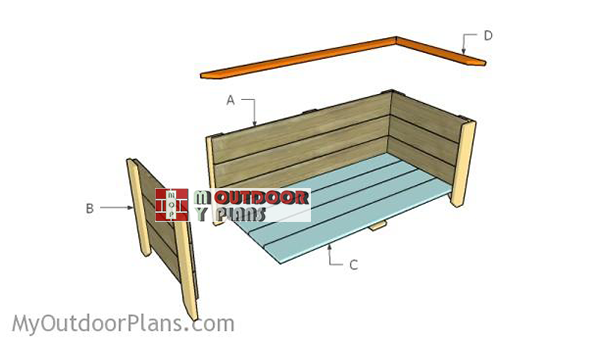
Building-a-large-planter
Cut & Shopping Lists
- A – 6 pieces of 1×6 lumber – 48″ long, 6 pieces – 22″ long FRAME
- B – 10 pieces of 1×4 lumber – 20″ long LEGS
- C – 4 pieces of 1×6 lumber – 46 1/2″ long BOTTOM
- D – 2 pieces of 1×3 lumber – 49 1/2″ long, 2 pieces – 25″ long TRIMS
- 7 pieces of 1×6 lumber – 8 ft
- 3 pieces of 1×4 lumber – 8 ft
- 2 pieces of 1×3 lumber – 8 ft
- 1 1/4″ screws
- 1 5/8″ screws
- 2 1/2″ screws
- filler, stain
- glue
Tools
![]() Hammer, Tape measure, Framing square, Level
Hammer, Tape measure, Framing square, Level
![]() Miter saw, Drill machinery, Screwdriver, Sander
Miter saw, Drill machinery, Screwdriver, Sander
Time
![]() One day
One day
How to build a large planter
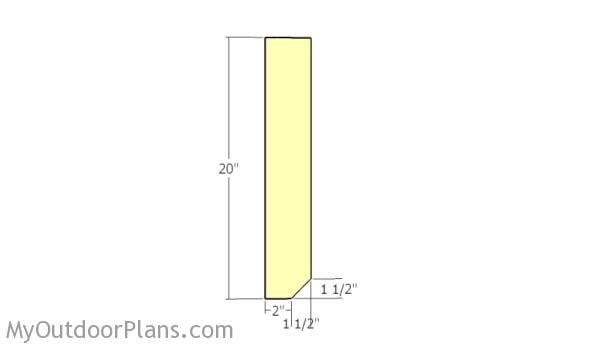
Building the legs
Firstly, you should build the legs for the outdoor planter. Cut the components from 1×4 lumber at the right size. As you can easily notice in the diagram, you should make decorative cuts to the bottom of the slats.

Building-the-sides
The next step of the project is to attach the slats for the sides of the planter. Cut the 1×6 slats at the right size and use 1 1/4″ screws to lock them to the legs. Drill pilot holes to prevent the wood from splitting. Leave no gaps between the components.
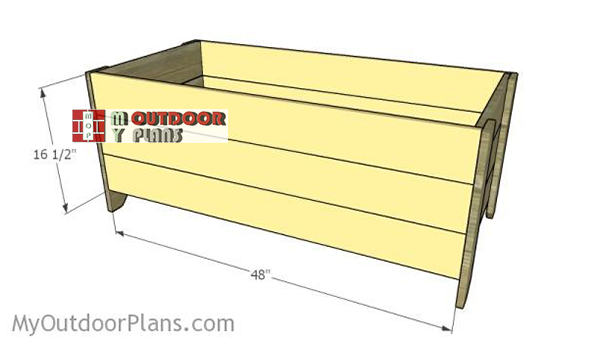
Fitting-the-front-and-back-panels
Next, you need to assemble the large planter by attaching the slats to the front and back, as shown in the diagram. Cut the slats at the right dimensions and drill pilot holes to prevent the wood from splitting, when inserting the 1 1/4″ screws. Leave no gaps between the slats and make sure the corners are right-angled.
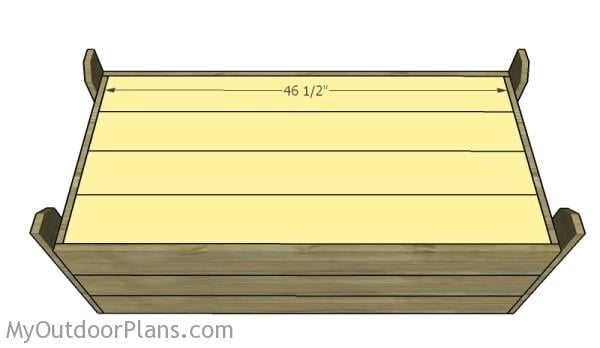
Installing the bottom slats
Use 1×6 or 2×6 slats for the bottom of the planter. Drill pilot holes through the frame of the planter and insert 2″ screws into the bottom slats. Leave no gaps between the slats and make sure the corners are right-angled.
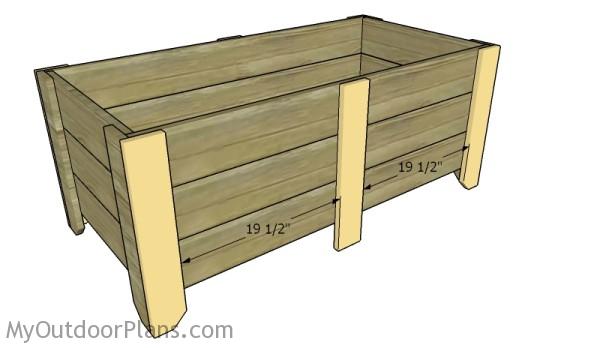
Attaching the front and back legs
Continue the project by fitting the legs to the front and to the back of the planter. Drill pilot holes through the slats and insert 1 1/4″ screws from the inside of the planter into the legs.
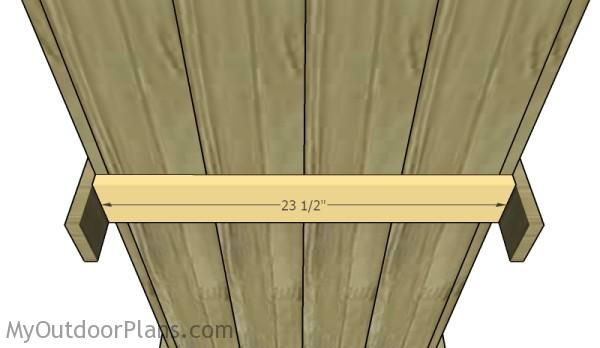
Attaching the middle support
Fit a 1×4 support under the planter, as shown in the diagram, to add extra-strength to the structure. Drill pocket holes at both ends of the support and insert 1 1/4″ screws into the legs. In addition, drill pilot holes and insert 1 1/4″ screws into the bottom slats.
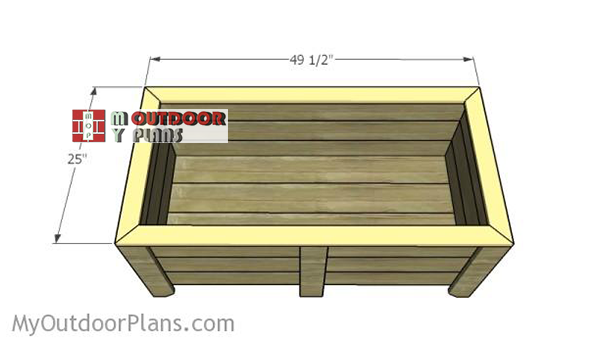
Fitting-the-top-trims
One of the last steps of the project is to attach the trims to the planter, as shown in the diagram. Cut both ends of the 1×3 slats at 45 degrees and secure them to the planter using 1 1/4″ brad nails. Leave no gaps between the components for a professional result.
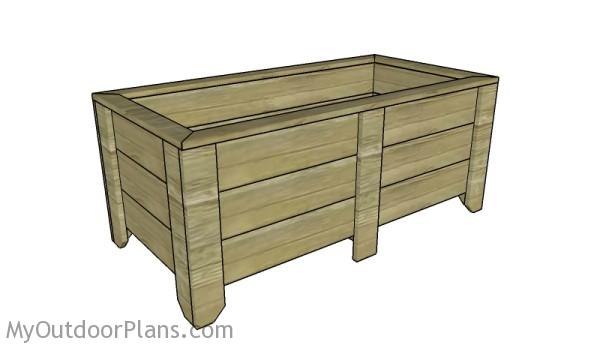
Large Planter Plans
Fill the holes and dents with wood putty and let it dry out for several hours. Use 120-200 grit sandpaper to smooth the surface. Remember that you can adjust the design and size of the planter to suit your needs. Staple landscaping fabric to the interior of the planter and fill it with dirt. Alternatively, you can use plastic containers to get the job done.
Top Tip: If you want to enhance the look of the project and to protect the components from decay, we recommend you to apply paint or stain.
This woodworking project was about wood rectangular planter box plans. If you want to see more outdoor plans, we recommend you to check out the rest of our step by step projects. LIKE us on Facebook and Google + to be the first that gets out latest projects and to hep us keep adding free woodworking plans for you.





7 comments
which are units of measurement (meters, centimeters or other)
Everything on this site is in inches. For conversion to meters you could check out this table: http://myoutdoorplans.com/imperial-to-metric-conversion/
Their are tape measures with both metric and imperial measurements on them.
Well I built this then had to take it apart, cut it down some and put it back together again.
The cut list states to cut all 1×6 461/2 however on the picture the side pieces show 48, unfortunately i cut all the pieces before looking at the picture on page 3.
Also when the sides are 22 there is a large gap in the bottom planks, so I had to take the sides apart and cut them back so the bottom planks would fit tight together.
When screwing the bottom planks in the ends, I had to take the legs off in order to get 2 screws equally spaced in the ends.
I will redo the plans for my next build and save some time and money.
The general ideal is great though.. thank you
Sorry for the error in the cut list and thank you for letting me know. I modified the list with the right measurements. Regarding the bottom slats, I don’t see where the problem could be. If you use 4 pieces of 1×6 for the bottom, then their added width should be exactly 22″, as the sizes. Maybe your 1x6s aren’t 5 1/2″ wide or maybe you are using 1x4s.
It doesnt specify in your instructions how many when it says to cut decorative cuts for the legs. I only cut 8 and left 2 flat for the middle.
That’s correct.